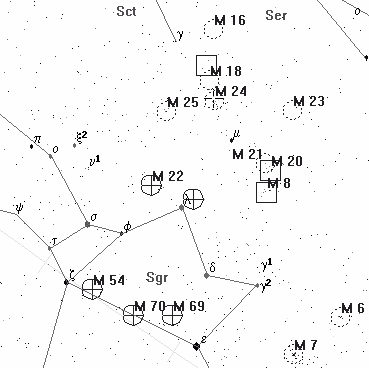M24 - "Neighboring" Arm
Jack Kramer
The star cluster M24 is a large, marvelously rich object in binoculars and in a wide-field telescope view. It's sometimes referred-to as the "Small Sagittarius Star Cloud". But there's more to M24 than at first meets the eye. In this area of Sagittarius, we're looking through a "hole" in the dust and star fields of our arm of the Milky Way, which normally obscures the view of what lies at the core of our galaxy. This hole allows us to see M24, which is actually a portion of the next spiral arm inward toward our galaxy's core. It's one of the only direct views we have of what things are like closer to the nucleus of our galaxy.
The hole through which we view M24 isn't all that transparent, but through it we can see what is called the "Norma Spiral Arm", of which M24 is a part. The nearby dense star clouds and dust which normally block our view is known as the "Sagittarius-Carina Spiral Arm". The clouds of this arm, in which are embedded the Lagoon, the Trifid, and the Swan emission nebulae, lie from about 5,000 to around 7,000 light years from us; the stars which comprise the M24 Star Cloud are estimated to be from 12,000 to 16,000 light years distant.
Another nearby hole is known as "Baade's Window" - an area so transparent that we're able to see a few star clusters beyond the galactic hub. (A couple of years ago, we had a newsletter article on Baade's Window; it's now archived on the LCAS web site.)
M24 also contains a nice little open cluster (NGC 6603) and a couple of easy dark nebulae (B92 and B93).
The Small Sagittarius Star Cloud is one of the very few Messier objects that doesn't have an NGC or IC number associated with it. Instead, the alternate designation of M24 is the more recent Melotte 197 (Mel 197). For many years, M24 was designated as NGC 6603. However, research indicates that in the New General Catalog, Dreyer originally identified 6603 as a discrete star cluster that appears within the Small Sagittarius Star Cloud. Moreover, it's generally conceded that when Messier logged M24, he was referring to the larger star cloud and not to the small cluster. In fact, there's no indication that Messier ever saw the small cluster. Likewise a few sources also refer to M24 as IC 4715, which is actually another Milky Way star cloud.

The Small Sagittarius Star Cloud definitely benefits from a wide field eyepiece, but it's also easily visible in binoculars and even with the naked eye in a dark sky. My observing notes record that NGC 6603 was seen as a small, concentrated cluster that stands out well from the rich star field of M24. Since NGC 6603 is composed mainly of 14th magnitude stars, it appears as a small, unresolved glowing spot in modest telescopes. The dark nebulae B92 and B93 lie adjacent to one another at the northwest end of M24. They show up easily as star-poor areas, again best seen using a wide field eyepiece.
Published in the August 2003 issue of the NightTimes




